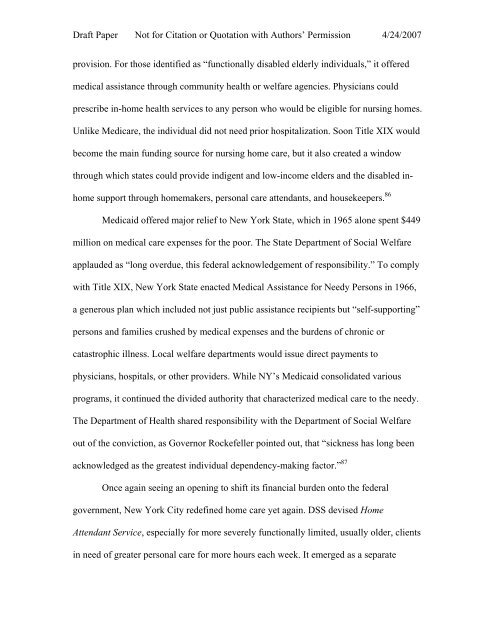Organizing Home Care: - School of Social Service Administration
Organizing Home Care: - School of Social Service Administration
Organizing Home Care: - School of Social Service Administration
Create successful ePaper yourself
Turn your PDF publications into a flip-book with our unique Google optimized e-Paper software.
Draft Paper Not for Citation or Quotation with Authors’ Permission 4/24/2007<br />
provision. For those identified as “functionally disabled elderly individuals,” it <strong>of</strong>fered<br />
medical assistance through community health or welfare agencies. Physicians could<br />
prescribe in-home health services to any person who would be eligible for nursing homes.<br />
Unlike Medicare, the individual did not need prior hospitalization. Soon Title XIX would<br />
become the main funding source for nursing home care, but it also created a window<br />
through which states could provide indigent and low-income elders and the disabled inhome<br />
support through homemakers, personal care attendants, and housekeepers. 86<br />
Medicaid <strong>of</strong>fered major relief to New York State, which in 1965 alone spent $449<br />
million on medical care expenses for the poor. The State Department <strong>of</strong> <strong>Social</strong> Welfare<br />
applauded as “long overdue, this federal acknowledgement <strong>of</strong> responsibility.” To comply<br />
with Title XIX, New York State enacted Medical Assistance for Needy Persons in 1966,<br />
a generous plan which included not just public assistance recipients but “self-supporting”<br />
persons and families crushed by medical expenses and the burdens <strong>of</strong> chronic or<br />
catastrophic illness. Local welfare departments would issue direct payments to<br />
physicians, hospitals, or other providers. While NY’s Medicaid consolidated various<br />
programs, it continued the divided authority that characterized medical care to the needy.<br />
The Department <strong>of</strong> Health shared responsibility with the Department <strong>of</strong> <strong>Social</strong> Welfare<br />
out <strong>of</strong> the conviction, as Governor Rockefeller pointed out, that “sickness has long been<br />
acknowledged as the greatest individual dependency-making factor.” 87<br />
Once again seeing an opening to shift its financial burden onto the federal<br />
government, New York City redefined home care yet again. DSS devised <strong>Home</strong><br />
Attendant <strong>Service</strong>, especially for more severely functionally limited, usually older, clients<br />
in need <strong>of</strong> greater personal care for more hours each week. It emerged as a separate
















